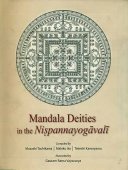Mahamayamandala, Mahāmāyāmaṇḍala, Mahamaya-mandala: 1 definition
Introduction:
Mahamayamandala means something in Buddhism, Pali. If you want to know the exact meaning, history, etymology or English translation of this term then check out the descriptions on this page. Add your comment or reference to a book if you want to contribute to this summary article.
In Buddhism
Tibetan Buddhism (Vajrayana or tantric Buddhism)
Source: archive.org: The Indian Buddhist IconographyMahāmāyāmaṇḍala (महामायामण्डल) refers to the maṇḍala (‘circle of worship’) of Mahāmāyā: one of the various emanations of Akṣobhya having their Sādhana described in the 5th-century Sādhanamālā (a collection of sādhana texts that contain detailed instructions for rituals).—Hevajra takes the name of Mahāmāyā when he is embraced by his Śakti Buddhaḍākinī and remains with her in yab-yum.
The Mahāmāyāmaṇḍala is described in the Sādhanamālā as follows:—
“Mahāmāyā is terrible in appearance. His body is besmeared with ashes and his hair streams upwards in the shape of a flame of fire. He is blue in colour and his head-dress is decorated with a row of skulls. His four faces are of blue, yellow, white and green colour, and he carries in his four hands the kapāla, the arrow, the khaṭvāṅga, and the bow. He is endowed with five auspicious symbols, has a torque round the neck and bracelets on his wrists. He is clad in human skin, has three eyes in each head, and flames of fire radiate from his body. He appears beautiful in his sentiment of mixed anger and delight, and stands in the ardhaparyaṅka in a dancing attitude. He is embraced by Buddhaḍākinī, who is red, carries the same weapons and has the same appearance and symbols as those of Mahāmāyā. Her four faces are red, yellow, white and green.
The four petals in the four cardinal directions of the lotus seat are occupied by the following goddesses:—
(1) Vajraḍākinī in the east, who is blue in colour with four faces of blue, yellow, white and green colour, and carries the khaṭvāṅga and the ghaṇṭā in the two left hands and the vajra and the kapāla in the two right.
(2) Ratnaḍākinī of yellow colour is in the south, with four faces of yellow, blue, red and green colour. She carries the flag and the jackal in her two left hands and the triśūla and the jewel in her two right.
(3) Padmaḍākinī in the west is of reddish white colour, has four faces of red, yellow, blue and green colour, and carries the bow and the kapāla in her two left hands and the arrow and the double lotus in the two right.
(4) Viśvaḍākinī in the north, of green colour, who has four faces of green, yellow, red and blue colour, and who carries the pāśa and the kapāla in her two left hands and the khaṭvāṅga (or the sword) and the ḍamaru in the two right.
These four deities exhibit wrath, have their heads decorated with a number of skulls, have garlands of heads still wet with blood, three eyes and portruding teeth. Their brown hair stream upwards in the shape of a flame, and flames of fire radiate from their persons.”

Tibetan Buddhism includes schools such as Nyingma, Kadampa, Kagyu and Gelug. Their primary canon of literature is divided in two broad categories: The Kangyur, which consists of Buddha’s words, and the Tengyur, which includes commentaries from various sources. Esotericism and tantra techniques (vajrayāna) are collected indepently.
See also (Relevant definitions)
Partial matches: Mandala, Mahamaya.
Full-text: Ratnadakini, Vishvadakini, Padmadakini, Vajradakini, Mahamaya.
Relevant text
No search results for Mahamayamandala, Mahāmāyāmaṇḍala, Mahamaya-mandala, Mahāmāyā-maṇḍala; (plurals include: Mahamayamandalas, Mahāmāyāmaṇḍalas, mandalas, maṇḍalas) in any book or story.
Related products
